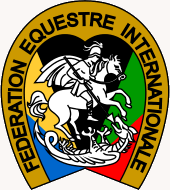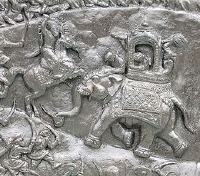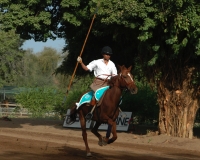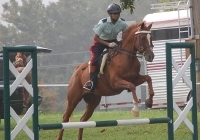 |
 |
| << return | ||
|
Tent Pegging with UNICEF Team Canada |
||
|
|
||
|
Of my many eccentricities, none is as improbable as my involvement in tent pegging. Often referred to as equestrian skill-at-arms, the sport has a mounted cavalier riding at a full gallop across a timed course, on the flat and over jumps, using sword, sabre, and lance to smite a succession of ground and elevated targets. Yes, really. Military cavaliers have practised tent pegging for more than two-and-a-half millennia, and it is one of only ten disciplines officially recognised by the FEI, the global governing body for Olympic and international equestrianism. I captained Canada's national team, and kept a blog of my experiences at the sport’s International Championships. Like most tent peggers, I was introduced to the sport through service with a cavalry regiment. Seat a man on a horse, hand him a sword, and set him off at a gallop: any ability to resist tent pegging will immediately and forever abandon him.
|
||
|
Global Governing Body for Equestrianism |
UNICEF Team Canada If I am able to acquit myself creditably, it is because of the kind dedication of each member of my team. I am more grateful to them than I could possibly express. Title Partner Equerry Stewards Coach Horses Mascot
|
|
|
Period engraving of tent pegging in the Rajput-Mogul wars
|
History and Contemporary Rules Although tent pegging's precise origins are obscured by the mists of time, the sport unquestionably emerged out of training exercises to develop military cavaliers' prowess with edged weapons; tent pegging is to the cavalry officer as jousting was to the mediaeval knight. The sport's rather opaque name is drawn from the small tent stakes that served as the original targets in military encampments. The most broadly accepted account of tent pegging's birth is as battle drill in the Indian Empire. The sport prepared horse cavaliers to charge and fell war elephants through finely placed lance strikes to the ponderous beasts' vulnerable feet. The mainstay of tent pegging remains lancing ground targets. However, the sport also includes: ring jousting (threading a blade through suspended rings); lemon sticking (slicing suspended targets); quintain tilting (charging swivelling mannequins); Parthian (mounted) archery; and cavalry revolver. All events are conducted at a full gallop. Rules for the modern sport are promulgated by the Fédération équestre internationale (FEI).
|
|
|
Mounted Lance |
Windmills Across Continents Tent pegging draws as much on nimbleness of mind as suppleness of limb, and is ideally suited to those whose antiquated notions of gallantry, valour, and martial honour would be thought absurd even by Don Quixote. Needless to day, it was inevitable that I should fall under its thrall. I took up the sport in 2005 as a member of the Governor General's Horse Guards Cavalry Squadron. In 2006, two colleagues from the Horse Guards and I recklessly entered the US National Cavalry Competition in Kentucky. To my surprise, I took a red and a blue ribbon in Mounted Sabre III and Military Field Jumping II, respectively. The following year, I threw caution to the wind, and began representing Canada in global competition. With tent pegging dominated by Old World cavalry cultures, I am conscious of being one of its few New World athletes, a novice in an ancient sport. Nevertheless, I can imagine no greater athletic privilege than to carry the maple leaf in competition, and I hope that I have represented our country with honour. I rode for Canada in at the 2007 International Championships in the Sultanate of Oman, and kept blog of the games. With results ranging from last to fourth in the separate disciplines, I was elated to have neither caused anyone's demise, nor met my own. I again rode for Canada at the 2008 International Championships in India, and once more kept a blog of the games. Against all rationality, of the four team disciplines, I returned home with three gold medals and one bronze medal. The sense of disbelief is unlikely to ever leave me! In 2010, I began tweeting directly from the field of honour, to produce a to-the-moment account of my misadventures in competition.
|
|
|
United Nations Children's Fund in Canada |
United Nations Children's Fund I have been a passionate supporter of UNICEF's work to save and improve the lives of the world's most vulnerable children since I was a child myself, one of the legions of Canadian pupils who carried the black and orange UNICEF Hallowe'en donation boxes. I continued to volunteer with the organisation while I was at university and after I returned home to Canada. Thus, rather than compete at the International Tent Pegging Championships under the logo of a corporate sponsor, I donated my team's naming rights to UNICEF. By riding under UNICEF's banner, I hope to lend prominence to and therefore advance UNICEF's advocacy work against childhood AIDS and against child labour. Moreover, I hope to help UNICEF with fund-raising, and I urge anyone who wishes to endorse my bid in the sport to do so by making a donation to UNICEF. Under our partnership, 100% of funds donated through UNICEF Team Canada go directly to UNICEF; no funds are retained by the equestrian team or pass from UNICEF to the team. I am profoundly honoured to serve as a UNICEF representative, and I compete with redoubled zeal knowing that I ride not only for my country, but also for the emancipation of children from exploitative labour and from the scourge of AIDS.
| |
|
Emblem of Canada's Equestrian Teams |
Tent Pegging in the News Although tent pegging is a less celebrated sport in Canada than in Old World nations, the sword and lance do sometimes penetrate the public consciousness in this hemisphere. "Canada is Tent Pegging Champion" "He Lives by the Sword" Metro Morning Blogs of the Championships Images of Tent Pegging
|
|
|
Military Field Jumping |
Taking Up the Sword Anyone interested in becoming involved in tent pegging may do so most easily by joining a local club. Residents of the Greater Toronto Area may wish to contact the Governor General's Horse Guards Cavalry Squadron in King City; the squadron is always eager to recruit new riders, irrespective of their level of experience. If you do not have a local club, please feel free to contact me. I should be happy to share advice and cautionary tales from my own misadventures, which you may find useful in initiating your own group.
| |
|
|
|
Remembering Desmond Tutu |
|
|
My article in the Globe and Mail |
|
TVOntario’s The Agenda |
|
|
Reflecting on the life of Queen Elizabeth II |
|
United Nations |
|
|
My address in the UN General Assembly Chamber |
|
CBC Radio’s The House |
|
|
The dirt on the federal two billion trees programme |
|
|
|





